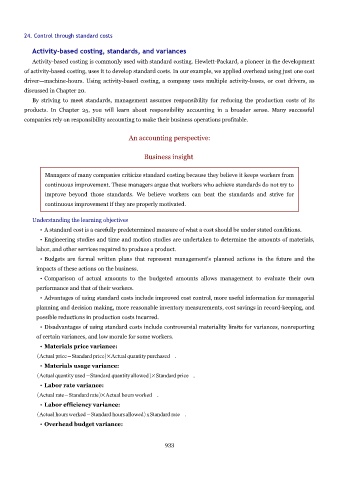Page 932 - Accounting Principles (A Business Perspective)
P. 932
24. Control through standard costs
Activity-based costing, standards, and variances
Activity-based costing is commonly used with standard costing. Hewlett-Packard, a pioneer in the development
of activity-based costing, uses it to develop standard costs. In our example, we applied overhead using just one cost
driver—machine-hours. Using activity-based costing, a company uses multiple activity-bases, or cost drivers, as
discussed in Chapter 20.
By striving to meet standards, management assumes responsibility for reducing the production costs of its
products. In Chapter 25, you will learn about responsibility accounting in a broader sense. Many successful
companies rely on responsibility accounting to make their business operations profitable.
An accounting perspective:
Business insight
Managers of many companies criticize standard costing because they believe it keeps workers from
continuous improvement. These managers argue that workers who achieve standards do not try to
improve beyond those standards. We believe workers can beat the standards and strive for
continuous improvement if they are properly motivated.
Understanding the learning objectives
• A standard cost is a carefully predetermined measure of what a cost should be under stated conditions.
• Engineering studies and time and motion studies are undertaken to determine the amounts of materials,
labor, and other services required to produce a product.
• Budgets are formal written plans that represent management's planned actions in the future and the
impacts of these actions on the business.
• Comparison of actual amounts to the budgeted amounts allows management to evaluate their own
performance and that of their workers.
• Advantages of using standard costs include improved cost control, more useful information for managerial
planning and decision making, more reasonable inventory measurements, cost savings in record-keeping, and
possible reductions in production costs incurred.
• Disadvantages of using standard costs include controversial materiality limits for variances, nonreporting
of certain variances, and low morale for some workers.
• Materials price variance:
Actual price−Standard price×Actual quantity purchased .
• Materials usage variance:
Actualquantity used−Standard quantityallowed ×Standard price .
• Labor rate variance:
Actual rate−Standard rate×Actual hoursworked .
• Labor efficiency variance:
Actual hoursworked−Standard hoursallowedxStandard rate .
• Overhead budget variance:
933

